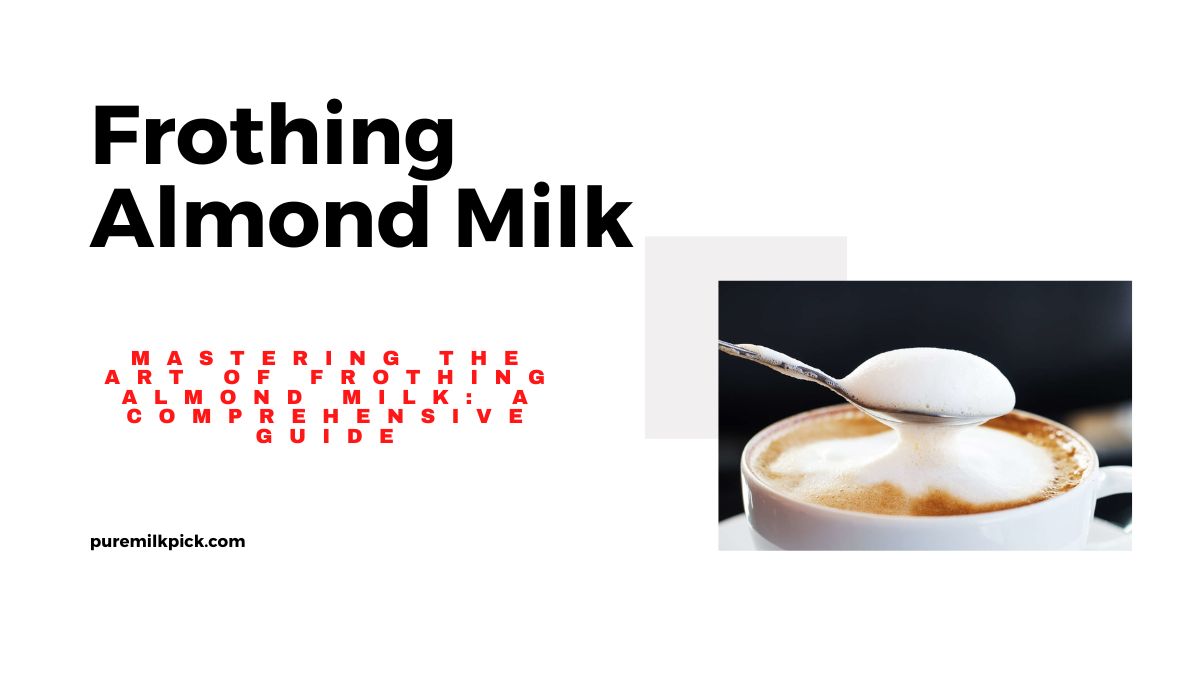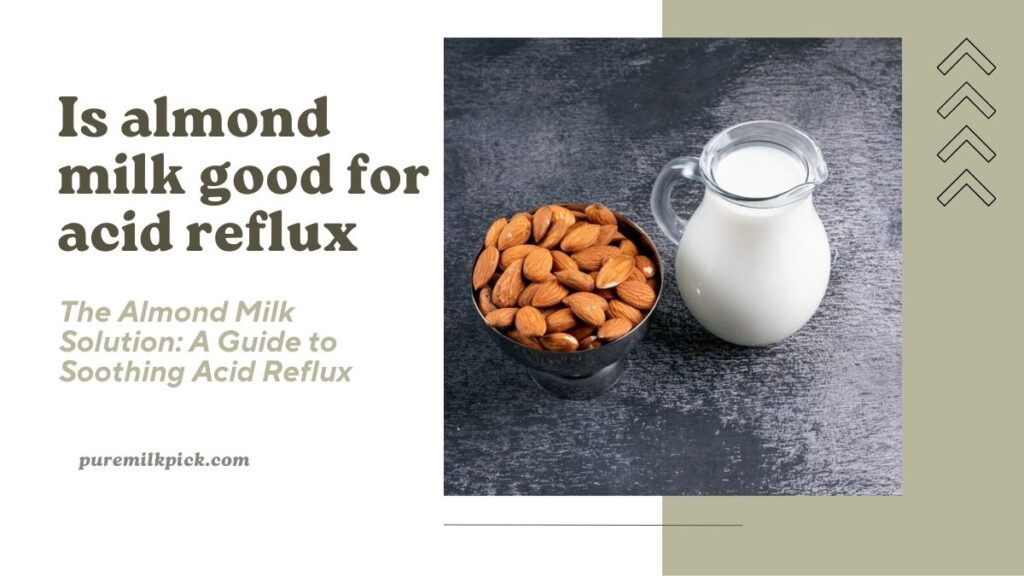In the realm of alternative milk options, almond milk has emerged as a popular choice, celebrated for its nutty flavor and versatility. However, to elevate your almond milk experience, enter the world of frothing. Imagine the rich, creamy texture enhancing your morning coffee or the frothy goodness adding a delightful twist to your favorite hot chocolate. In this comprehensive guide, we will delve into the art of frothing almond milk, exploring its benefits, techniques, and applications.
Benefits of Almond Milk Frothing
Enhanced Texture and Mouthfeel
One of the primary reasons enthusiasts turn to frothing almond milk is the transformation it brings to its texture. Frothing creates a velvety, creamy consistency, akin to traditional dairy milk. This enhanced mouthfeel adds a luxurious touch to your beverages, making each sip a delightful experience. The frothiness also contributes to the overall visual appeal, inviting you to savor the moment.
Beyond aesthetics, the texture plays a crucial role in creating specialty drinks. Whether you are crafting a latte or a cappuccino, the frothed almond milk blends seamlessly with the coffee, providing a harmonious balance that captivates the palate. The microfoam generated during the frothing process holds the key to achieving that perfect consistency, making your almond milk beverages a true indulgence.
Versatility in Creating Different Beverages
Frothed almond milk is a game-changer for those seeking versatility in their beverage choices. Its adaptability allows you to experiment with various coffee and tea creations, providing an excellent base for both hot and cold drinks. From macchiatos to iced lattes, the frothing process unlocks a world of possibilities, turning your kitchen into a personalized coffee shop.
Moreover, the frothing technique empowers you to explore a spectrum of flavors and aromas. The almond undertones mingle with the coffee or tea, creating a symphony of taste that transcends the ordinary. Whether you are a seasoned barista or a home coffee enthusiast, mastering the art of almond milk frothing opens up a realm of creative possibilities.
Read More: Unveiling the Magic of Powdered Almond Milk: Your Ultimate Guide
Dairy-Free and Vegan Alternative
Almond milk frothing is a revelation for individuals with dietary restrictions or those embracing a plant-based lifestyle. As a dairy-free and vegan alternative, almond milk caters to a diverse range of preferences and dietary needs. Frothing almond milk allows you to enjoy the richness and creaminess of traditional milk-based froths without compromising on ethical choices.
Choosing almond milk over dairy not only aligns with sustainability principles but also offers health benefits. Almond milk is naturally lower in calories, making it a lighter option for those conscious of their calorie intake. The absence of lactose makes it an ideal choice for individuals with lactose intolerance, expanding the reach of frothed beverages to a broader audience.
Choosing the Right Almond Milk
Importance of Selecting the Right Almond Milk for Frothing
Before delving into the frothing process, it’s essential to choose the right almond milk. The market is flooded with options, ranging from sweetened to unsweetened and fortified to homemade. The key lies in selecting almond milk that froths well, creating a stable and creamy microfoam.
Opt for unsweetened almond milk to have better control over the sweetness of your final beverage. Sweetened varieties may introduce an unwanted sugariness, affecting the overall balance. Additionally, choose almond milk labeled as “barista” or “barista blend” for optimal frothing results. These varieties are specifically formulated to withstand the frothing process, ensuring a consistent and stable foam.
Comparison of Different Almond Milk Brands
Navigating the vast array of almond milk brands can be overwhelming. To simplify your decision-making process, consider popular and reputable brands known for their froth-friendly almond milk. Brands like Califia Farms, Almond Breeze Barista Blend, and Silk Almond Milk Barista Series are well-regarded for their ability to produce a creamy and stable foam.
When comparing brands, consider factors such as texture, taste, and frothing capabilities. Reading reviews and seeking recommendations from fellow frothing enthusiasts can provide valuable insights. Remember, the right almond milk can make all the difference in achieving that perfect froth for your favorite beverages.
Consideration of Homemade Almond Milk
While store-bought almond milk offers convenience, homemade almond milk provides a personalized touch to your frothing experience. Making almond milk at home allows you to control the ingredients, ensuring a pure and unadulterated base for frothing. Additionally, homemade almond milk tends to be fresher, enhancing the overall flavor profile of your beverages.
To make homemade almond milk suitable for frothing, use a high-quality blender to achieve a smooth and consistent texture. Strain the milk to remove any remaining almond pulp, ensuring a silky froth. Experiment with different ratios of almonds to water to find the perfect balance for your frothing endeavors. The satisfaction of frothing with almond milk crafted from scratch adds a special touch to your beverage ritual.

Frothing Techniques
Overview of Frothing Methods
Frothing almond milk can be accomplished through various methods, each catering to different preferences and equipment availability. The two primary techniques involve using a milk frother and frothing without specialized equipment. Understanding these methods allows you to choose the approach that best suits your setup and desired froth consistency.
Using a Milk Frother
Investing in a dedicated milk frother is a game-changer for almond milk enthusiasts. These devices are designed to create a consistent and velvety froth with minimal effort. To use a milk frother, heat your almond milk to the desired temperature, insert the frother’s whisk into the milk, and activate the frothing function. The result is a luxurious microfoam that elevates your beverages to barista-level quality.
Milk frothers come in various designs, including handheld frothers and automatic frothing wands. Handheld frothers are convenient and budget-friendly, while automatic wands are integrated into some espresso machines, streamlining the frothing process. Whichever option you choose, a milk frother provides a hassle-free way to achieve professional-grade frothed almond milk.
Frothing Without Specialized Equipment
Not everyone has access to a milk frother, but fear not—frothing almond milk without specialized equipment is entirely feasible. This method requires a bit more hands-on effort but can yield satisfying results with practice. Start by heating your almond milk on the stove or in the microwave until it’s warm but not boiling.
Once heated, transfer the almond milk to a heatproof container and use a manual frother, such as a French press plunger or a whisk, to froth the milk vigorously. The goal is to introduce air into the milk, creating bubbles and achieving a frothy consistency. While it may take a few attempts to perfect the technique, frothing without specialized equipment is a cost-effective solution for those who enjoy a hands-on approach to their beverage preparation.
Tips for Successful Almond Milk Frothing
Temperature Considerations
Achieving the perfect froth begins with the right temperature. Almond milk froths best when it is heated to around 150 to 155 degrees Fahrenheit (65 to 68 degrees Celsius). This temperature range allows the proteins and fats in the almond milk to interact, creating a stable microfoam. Be cautious not to overheat the almond milk, as temperatures above 160 degrees Fahrenheit can lead to scalding and affect the frothing quality.
To ensure precise temperature control, use a kitchen thermometer or the temperature settings on your milk frother. Consistency in temperature is key to producing a froth that complements your beverages, so take the time to monitor and adjust accordingly.
Frothing Time and Consistency
The duration of frothing plays a crucial role in determining the texture and consistency of the almond milk froth. Over-frothing can lead to large, unstable bubbles, while under-frothing may result in a lackluster foam. Finding the sweet spot requires experimentation, but a general rule of thumb is to froth for around 30 to 60 seconds.
Pay attention to the visual cues during the frothing process. The ideal almond milk froth should be creamy, with a consistency that resembles wet paint. Once you achieve this texture, stop frothing to prevent overprocessing. The goal is to create a microfoam that enhances the beverage without overshadowing its flavor.
Common Troubleshooting Tips
Even seasoned frothers encounter challenges from time to time. Understanding common issues and their solutions can save you from disappointment and help you master the art of almond milk frothing.
- Flat Froth: If your froth lacks volume and appears flat, ensure that your almond milk is fresh and hasn’t expired. Additionally, double-check the frothing technique and temperature, making adjustments as needed.
- Large Bubbles: Large bubbles in the froth can result from over-frothing. To remedy this, use a gentle swirling motion to break down the bubbles and create a smoother texture.
- Inconsistent Froth: Inconsistencies in the froth may stem from uneven heating. Stir the almond milk before frothing to distribute the heat evenly and achieve a uniform texture.
By honing these temperature, time, and troubleshooting considerations, you’ll navigate the frothing process with confidence, ensuring a delightful frothed almond milk experience every time.

Recipes and Applications
Almond Milk Lattes
Almond milk lattes are a classic favorite, combining the rich flavor of coffee with the creamy texture of frothed almond milk. To create the perfect almond milk latte, start by brewing a strong espresso or a robust coffee. Heat your almond milk to the optimal frothing temperature and use your preferred frothing method to create a velvety microfoam. Pour the frothed almond milk over the brewed coffee, creating a beautiful latte art if desired. The result is a harmonious blend of nutty undertones and bold coffee flavors, making every sip a luxurious experience.
Almond Milk Cappuccinos
For those who appreciate a stronger coffee presence, almond milk cappuccinos are the ideal choice. Begin by brewing a shot of espresso, ensuring a robust and concentrated flavor. Froth your almond milk to create a dense and creamy microfoam. The key to a perfect almond milk cappuccino lies in the balance between coffee and froth. Pour the frothed almond milk over the espresso, allowing the foam to rise to the top. The result is a delightful combination of strong coffee notes and a velvety froth, creating a cappuccino that rivals any traditional dairy-based version.
Almond Milk Hot Chocolate
Almond milk hot chocolate introduces a comforting and indulgent twist to a classic beverage. Start by heating your almond milk to the desired temperature, ensuring it is warm but not boiling. Whisk in high-quality cocoa powder and your preferred sweetener to create a rich chocolate base. Froth the almond milk until it reaches a creamy consistency, then pour it over the chocolate mixture. The result is a luxurious and dairy-free hot chocolate that combines the goodness of almond milk with the irresistible allure of cocoa.
Incorporating Frothed Almond Milk into Desserts
The versatility of frothed almond milk extends beyond beverages, making it a delightful addition to desserts. Incorporating frothed almond milk into your favorite dessert recipes, such as pancakes, and waffles, or even creamy desserts like rice pudding. The froth adds a light and airy texture, elevating the overall indulgence of your sweet creations. Get creative in the kitchen and explore the ways frothed almond milk can enhance both traditional and innovative dessert recipes.
Health Considerations
Nutritional Benefits of Almond Milk
Beyond its frothing capabilities, almond milk boasts a range of nutritional benefits. As a plant-based milk alternative, almond milk is naturally low in calories, making it a suitable option for those aiming to maintain or lose weight. It is also a rich source of vitamin E, an antioxidant that supports skin health and provides essential minerals like calcium and magnesium for bone health.
While almond milk is lower in protein compared to dairy milk, it remains a good source of plant-based protein, making it a valuable addition to a balanced diet. Additionally, almond milk is naturally lactose-free, making it an excellent choice for individuals with lactose intolerance.
Allergen Considerations
For individuals with dairy allergies or lactose intolerance, almond milk serves as a safe and nutritious alternative. However, it’s crucial to note that almonds are tree nuts, and individuals with nut allergies should exercise caution. In such cases, alternative milk options, such as soy milk or oat milk, may be more suitable.
When introducing almond milk into your diet, start with small quantities to assess for any allergic reactions. If you have known nut allergies, consult with a healthcare professional before incorporating almond milk into your routine.
How Frothing May Impact Nutritional Content
While frothing almond milk enhances its texture and flavor, it’s essential to consider the impact on nutritional content. The frothing process itself doesn’t significantly alter the nutritional profile of almond milk, as it primarily involves aerating the liquid. However, if you choose a store-bought almond milk with added ingredients like sweeteners or thickeners, be mindful of their nutritional implications.
Homemade almond milk, on the other hand, allows you to control the ingredients and maintain a purer and more natural nutritional profile. By frothing homemade almond milk, you enjoy the benefits of a creamy texture without compromising on nutritional integrity.

Sustainability and Ethical Practices
Overview of Almond Milk Production
Understanding the production process of almond milk sheds light on its sustainability and ethical considerations. Almond milk is typically made by blending almonds with water, followed by straining to remove solid particles. While almonds are a water-intensive crop, advancements in agricultural practices and water-efficient farming techniques are contributing to a more sustainable almond industry.
It’s worth noting that the almond industry has made strides in adopting more environmentally friendly practices, including the utilization of almond by-products for animal feed and the implementation of water recycling systems. As consumers, being aware of these initiatives allows us to make informed choices that align with sustainable and ethical values.
Sustainable and Ethical Almond Milk Brands
Choosing almond milk from brands committed to sustainability and ethical practices further contributes to positive change. Some almond milk brands prioritize responsible sourcing of almonds, water conservation, and eco-friendly packaging. Brands like Elmhurst 1925, which embraces a “clean label” approach, and Oatly, known for its commitment to sustainable practices, are excellent choices for conscious consumers.
When selecting almond milk, explore the brand’s website or packaging for information on their sustainability practices. Supporting brands that prioritize ethical and environmentally responsible production contributes to the overall improvement of industry practices.
Reducing the Environmental Impact on Almond Milk Consumption
As consumers, we can play a role in reducing the environmental impact of almond milk consumption. Opt for almond milk brands that prioritize sustainable and ethical practices, and consider purchasing in larger quantities to minimize packaging waste. Additionally, explore alternative plant-based milk options, such as oat milk or pea milk, to diversify your choices and support a more sustainable food industry.
By making informed choices and advocating for sustainable practices, we contribute to a collective effort towards a more environmentally friendly future.
Conclusion
In conclusion, mastering the art of frothing almond milk is a journey of exploration, creativity, and mindful consumption. From understanding the benefits of almond milk frothing to choosing the right almond milk and exploring various frothing techniques, this guide aims to equip you with the knowledge and skills to elevate your beverage experience.
As you embark on your almond milk frothing adventures, remember that the process is as much about experimentation as it is about precision. Whether you’re a seasoned barista or a curious home enthusiast, the world of frothed almond milk invites you to savor the possibilities and craft beverages that reflect your unique taste and preferences.
So, why not embark on this flavorful journey? Frothing almond milk isn’t just a technique; it’s an art that adds a touch of luxury to your daily rituals. Whether you’re sipping a frothy almond milk latte or incorporating froth into your favorite dessert, the experience is bound to be nothing short of indulgent.
As you delve into the world of almond milk frothing, embrace the joy of creation, celebrate the richness of flavors, and relish in the satisfaction of mastering a skill that transforms ordinary moments into extraordinary ones.
Frequently Asked Questions (FAQs)
Yes, most milk frothers, whether handheld or automatic, are designed to froth almond milk. However, for optimal results, it’s recommended to use almond milk labeled as “barista” or “barista blend,” as these varieties are specifically formulated for frothing.
Absolutely! Homemade almond milk can be frothed using the same techniques as store-bought varieties. Ensure that your homemade almond milk is smooth and well-trained for the best frothing results.
To make almond milk frothier, you can experiment with adjusting the frothing time, temperature, and the type of almond milk used. Frothing for a slightly longer duration or using a higher fat-content almond milk can often result in a creamier and frothier texture.



